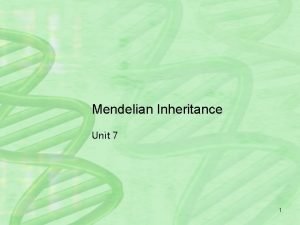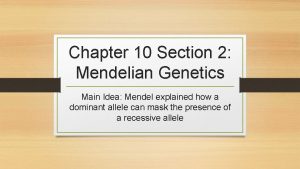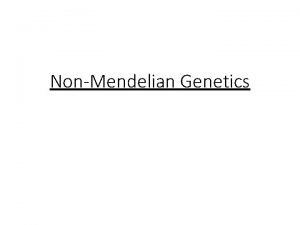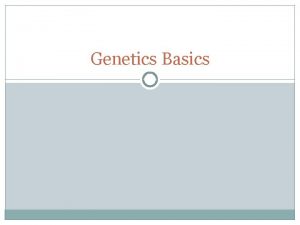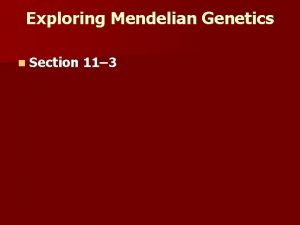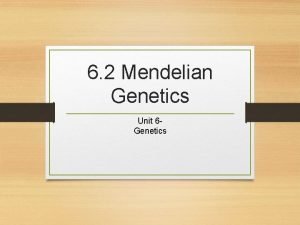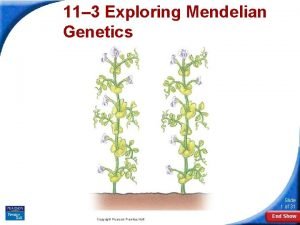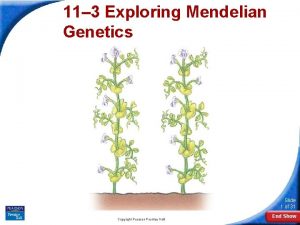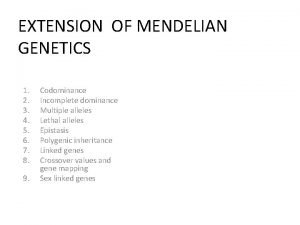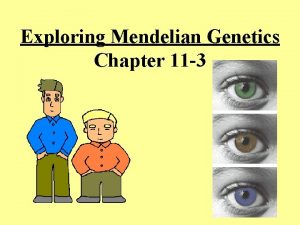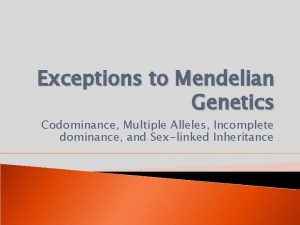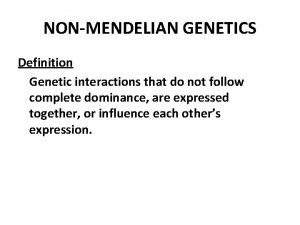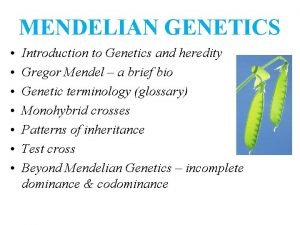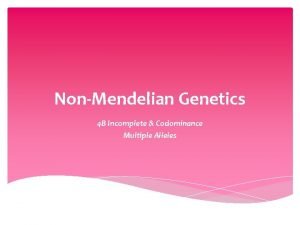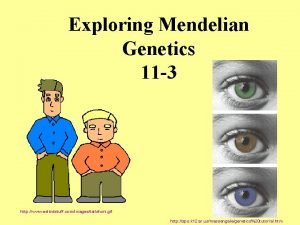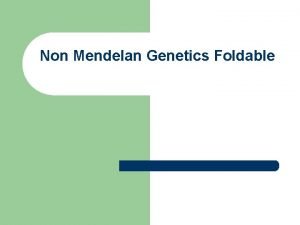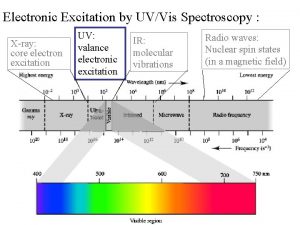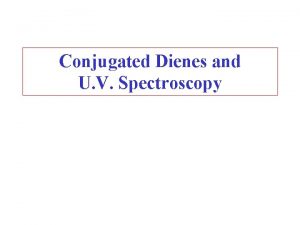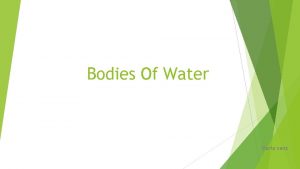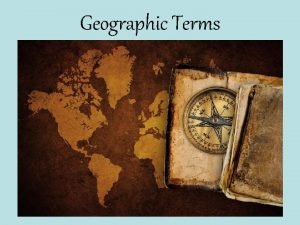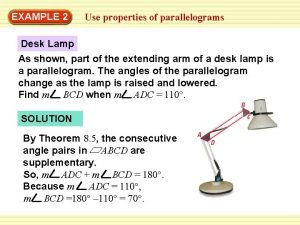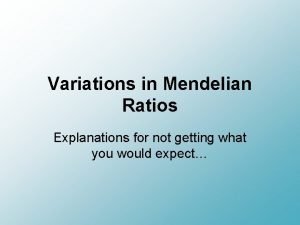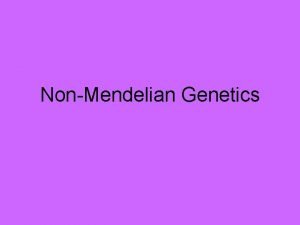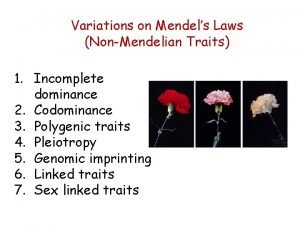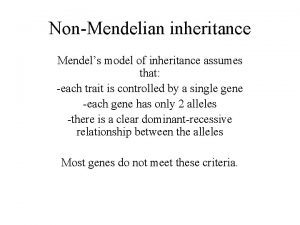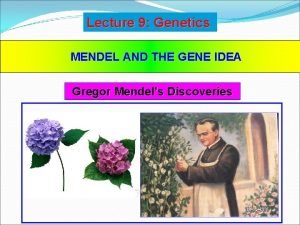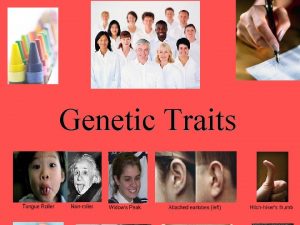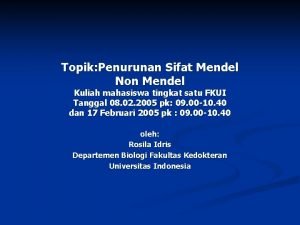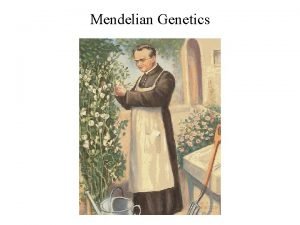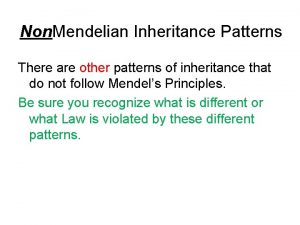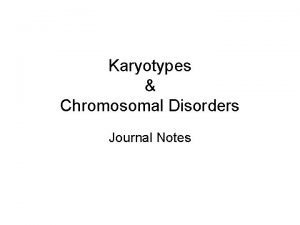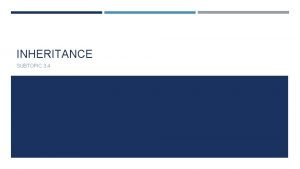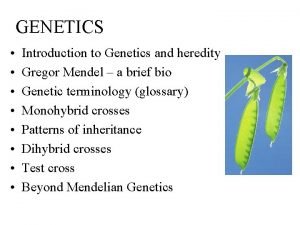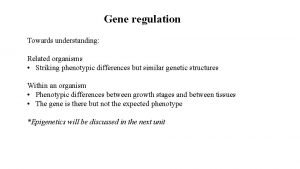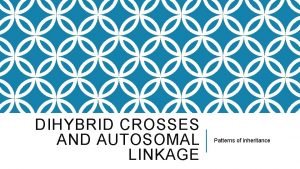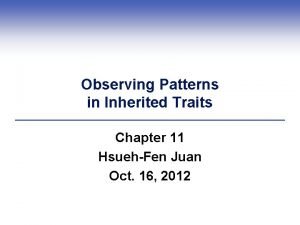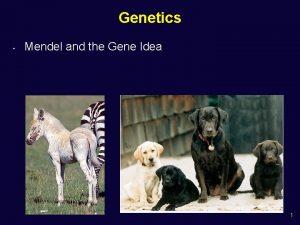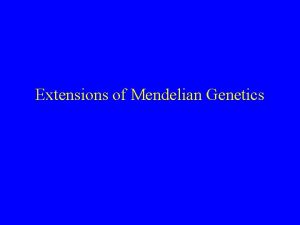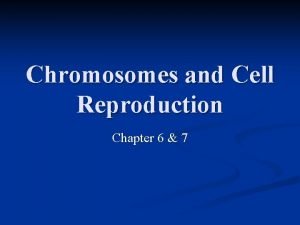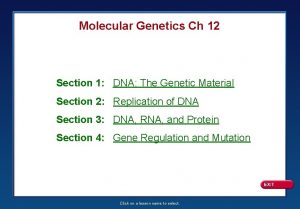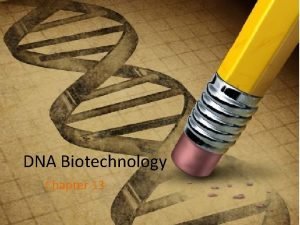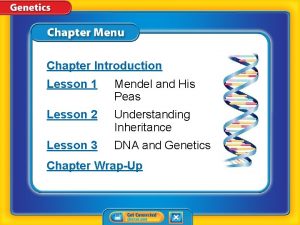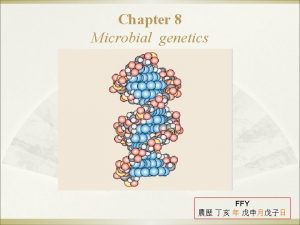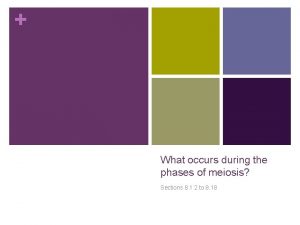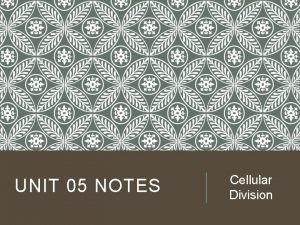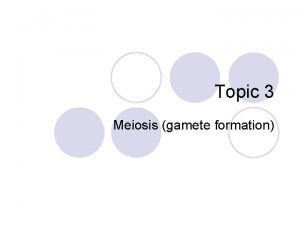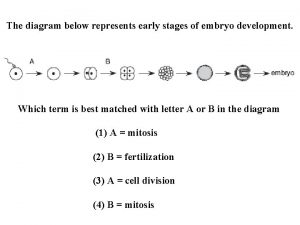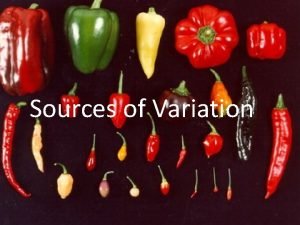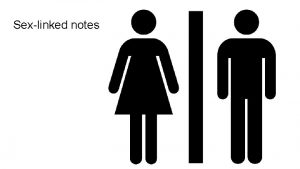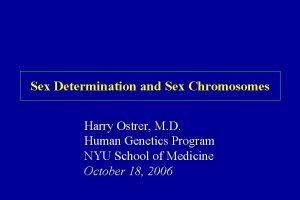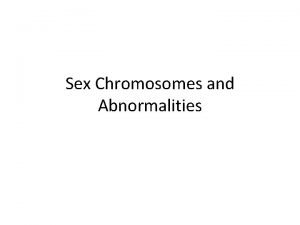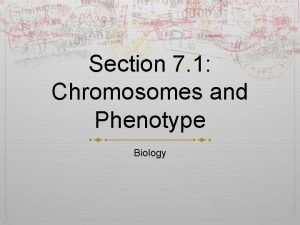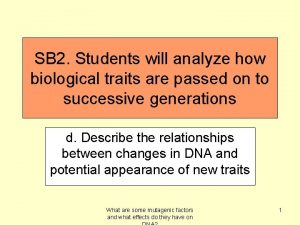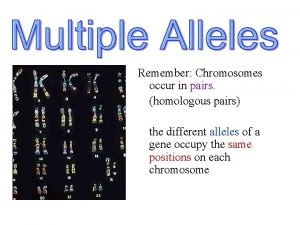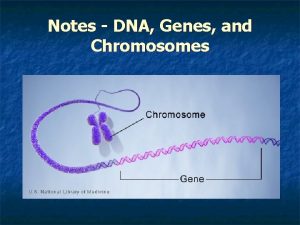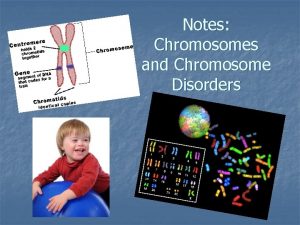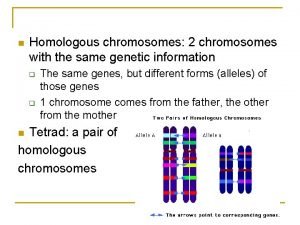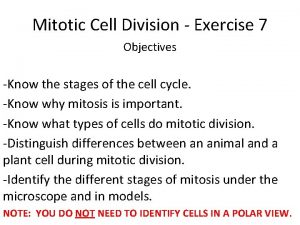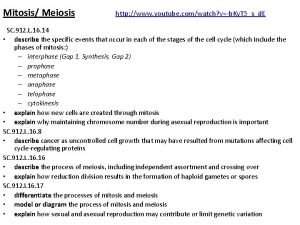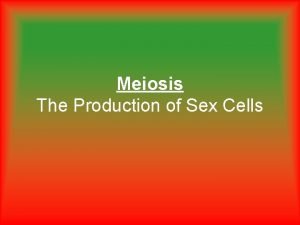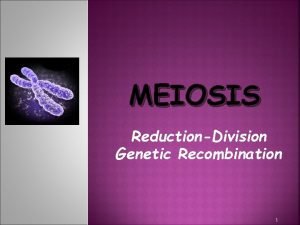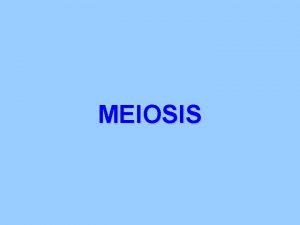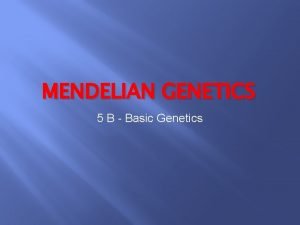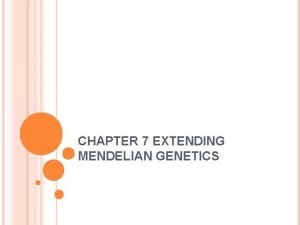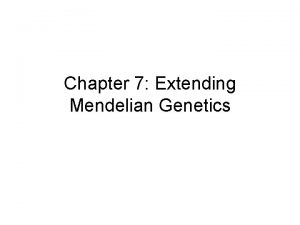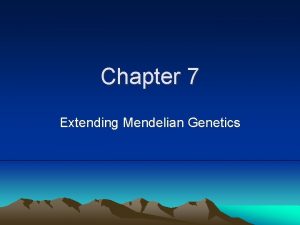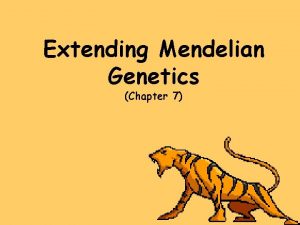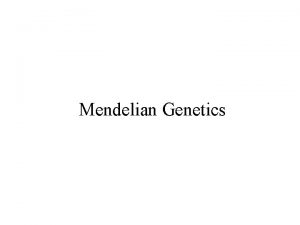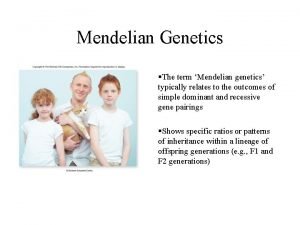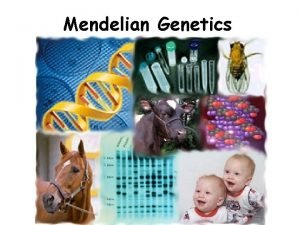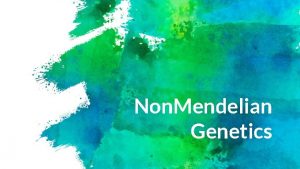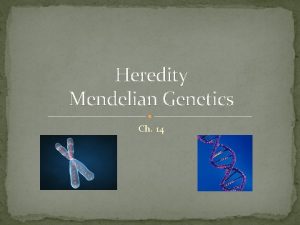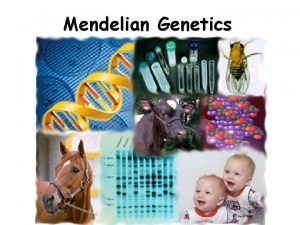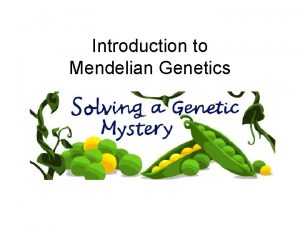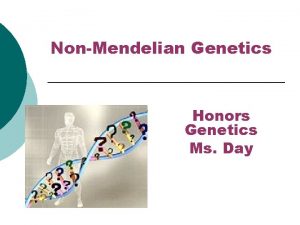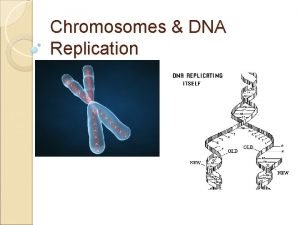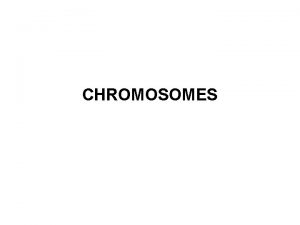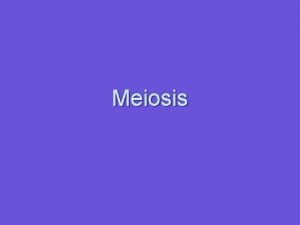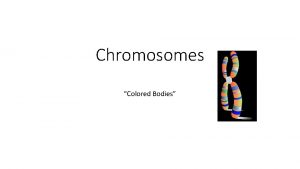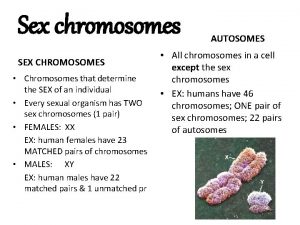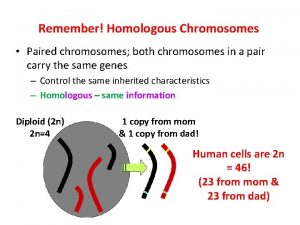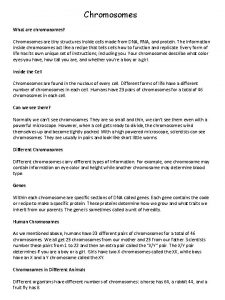GENETICS Chapter 7 Extending Mendelian Genetics I Chromosomes
























































































- Slides: 88

GENETICS Chapter 7: Extending Mendelian Genetics I. Chromosomes and Phenotype (7. 1) A. Two copies of each autosomal gene affect phenotype 1. Most human traits are a result of autosomal genes

2. Many human genetic disorders also caused by autosomal genes a. Chance of having disorder can be predicted b. Use same principles as Mendel did

B. Disorders Caused by Recessive Alleles 1. Some disorders are caused by recessive alleles on autosomes (dominant)

2. Must have two copies of recessive allele to have disorder a. Disorders often appear in offspring of parents who are heterozygous b. Cystic Fibrosis- recessive disorder that affects sweat glands and mucus glands.

3. A person who is heterozygous for a disease is called a carrier - does not show disease symptoms

C. Disorders Caused by Dominant Alleles 1. Less common than recessive disorders

2. Huntington’s Disease- damages nervous system and usually appears during adulthood. a. 75% chance if both parents heterozygous b. Since disease strikes later in life, person can have children before disease appears. Allele is passed on even though disease is fatal.

E. Males and Females can differ in sex-linked traits 1. Mendel figured out much about heredity, but did not know about chromosomes a. Mendel only studied autosomal traits b. Expression of genes on sex chromosomes differs from autosomal genes

2. Sex-linked Genes a. Genes located on sex-chromosomes are called sex-linked genes b. Many species have specialized sex chromosomes 1). In mammals and some other animals, individuals with XX are female and XY are male 2). X chromosome much larger than Y

3. Expression of Sex-Linked Genes a. Males only have one copy of each chromosome (XY)

1). Express alleles on each chromosome 2). No second copy of another allele to mask effects of another allele (all recessive alleles expressed)

Y-linked Genes –caused by gene found on Y Genes chromosome that is not homologous with X chromosome (called holandric gene) Not many gene holandric genes Is it possible for a female to inherit a holandric trait? “Hairy Ears”- (hypertrichosis)

b. In each cell of female, one of two X-chromosome is randomly “turned off”. 1). Called X Chromosome Inactivation 2). Creates patchwork of two types of cells

The individual with normal color vision will see a 5 revealed in the dot pattern. An individual with Red/Green (the most WHAT NUMBER DO YOU SEE? common) color blindness will see a 2 revealed in the dots.

Colorblind individuals should see the yellow square. Color normal individuals should see the yellow square Try and find a circle, star, and/or square in 3 and a "faint" brown circle. seconds.

Colorblind individuals should see the yellow circle. Color Try and find a circle, star, and/or square in 3 seconds. normal individuals should see the yellow circle and a "faint" brown square.



YOUNG WOMAN OR OLD WOMAN?


Multiple Alleles- More than two possible alleles exist for a trait (e. g. blood type, eye color)

II. Complex Patterns of Inheritance (7. 2) A. Phenotypes can depend on interactions of alleles 1. Many traits are result from alleles with range of dominance, rather than a strict dominant and recessive relationship 2. In many cases, phenotypes result from multiple genes

B. Incomplete Dominance 1. Neither allele completely dominant 2. Heterozygous phenotype somewhere between homozygous phenotypes (“blending”) Phenotype Genotype green B 1 Phenotype Genotype Steel blue Royal blue B 2 B 1 B 2

C. Codominance 1. Both traits are expressed completely 2. Can sometimes look like “blending” of traits, but actually show mixture of both X red = white roan

Co-Dominance In certain varities of chickens, black and white feather colors are caused by codominant alleles. Thus the heterozygous phenotype, speckled black and white, is a result of the expression of both alleles

3. Human blood type is example of codominance a. Also has 3 different alleles- trait also considered a multiple-allele trait b. When alleles are neither dominant of recessive (in both incomplete and codominance) use upper case letters with either subscripts or superscripts)

b. Human eye color shows at least 3 genes (hypothesize that are still genes undiscovered as well) Order of dominance: brown > green > blue.

2. Epistasis- when one gene overshadows all of the others. Albinism is caused by this type of gene

D. Many genes may interact to produce one trait 1. Polygenic traits- two or more genes determine trait a. Skin color result of four genes that interact to produce range of colors

Albinism is a autosomal Albinism recessive trait. Because the allele is recessive, individuals who are heterozygous for the trait express their normal skin color, sot he presence of the allele is “hidden” by the dominance of the normal allele. Albinos are unable to synthesize melanin, the pigment molecule responsible for most human skin coloring

3. The environment interacts with genotype a. Phenotype is more than sum of gene expression b. Sex of sea turtles depends on genes and environment. Temperature when eggs develop determine sex

c. Human traits also affected by environment (nutrition and health care)

The expression of coat color genes in Siamese cats varies with temperatures. Black pigment is produced only in those areas of the skin which are lowest in temperature, such as the ears and tail

Color of Hydrangea flowers is influenced by soil p. H

III. Gene Linkage and Mapping (7. 3) A. Gene linkage was explained through fruit flies 1. Thomas Hunt Morgan worked with fruit flies (Drosophila melanogaster) 2. Some traits seemed to be inherited together. Morgan called them linked traits. (found on same chromosome) Wild type Mutant

3. Morgan concluded that because linked genes were not inherited together every time that chromosomes must exchange homologous genes during meiosis (crossing over)

B. Linkage maps estimate distances between genes 1. Closer together- more likely inherited together 2. Further apart- more likely will be separated during meiosis.

IV. Human Genetics and Pedigrees (7. 4) A. Human genetics follows the patterns seen in other organisms 1. Meiosis independently assorts chromosomes when gametes are made for sexual reproduction 3. Human heredity involves same relationships between alleles (dominant/recessive, polygenic, sex-linked, etc)

B. Inheritance of some traits very complex 1. Multiple genes and alleles can interact 2. Single-gene traits can still be observed a. Many examples of single-gene traits (hairline-widows peak)

b. Many genetic disorders also caused by singlegene traits (Huntington’s disease, hemophilia, Duchenne’s muscular dystrophy)

c. Much of what is known about human genetics comes from studying genetic disorders

C. Females can carry a sex-linked genetic disorder 1. Both male and females can be carriers of autosomal disorders 2. Only females can be carriers of sexlinked disorders

3. Many genetic disorders carried on X-chromosome a. Male who has gene for disorder on X-chromosome will have disorder b. Males more likely to have this disorder

Some X-linked Recessive Genetic Traits

D. A pedigree is a chart for tracing genes in a family 1. Phenotypes are used to infer genotypes on a pedigree 2. Autosomal genes show different patterns on a pedigree than sex-linked genes.

a. Autosomal genes

b. Sex-linked genes

E. Several methods help map human chromosomes 1. Human genome so large difficult to map 2. Several methods used a. Pedigrees used for studying genetics in family

C. Human Geneshuman genome contains 20 -000 to 30, 000 genes. Much lower than earlier estimates of 80, 000 to 140, 000 1. Contains 3164. 7 million chemical nucleotide bases (A, C, T and G) 2. 99. 9% of all nucleotide bases are exactly the same in all people 3. Less than 2% of genome actually codes for proteins

b. Karyotypes- picture of all chromosomes in a cell 1). Stains used to produce patterns of bands


2). Used to identify certain genetic disorders in which there are extra or too few chromosomes (i. e. Down syndrome

Sex Chromosome disorders • In females, nondisjunction can lead to Turner’s Syndrome (XO) sex organs fail to Syndrome develop at puberty No Y chromosome

In males, nondisjunction causes Klinefelter’s syndrome (XXY) extra X interferes with meiosis syndrome and usually prevents individuals from reproducing

Chapter 7 Extending Mendelian Genetics

How many chromosomes are shown in a normal human karyotype? a. 2 b. 23 c. 44 d. 46

How many chromosomes are shown in a normal human karyotype? a. 2 b. 23 c. 44 d. 46

Which of the following are shown in a karyotype? a. homologous chromosomes b. sex chromosomes c. autosomes d. all of the above

Which of the following are shown in a karyotype? a. homologous chromosomes b. sex chromosomes c. autosomes d. all of the above

Which of the following can be observed in a karyotype? a. a change in a DNA base b. an extra chromosome c. genes d. alleles

Which of the following can be observed in a karyotype? a. a change in a DNA base b. an extra chromosome c. genes d. alleles

In humans, a male has a. one X chromosome only. b. two X chromosomes. c. one X chromosome and one Y chromosome. d. two Y chromosomes.

In humans, a male has a. one X chromosome only. b. two X chromosomes. c. one X chromosome and one Y chromosome. d. two Y chromosomes.

Human females produce egg cells that have a. one X chromosome. b. two X chromosomes. c. one X or one Y chromosome. d. one X and one Y chromosome.

Human females produce egg cells that have a. one X chromosome. b. two X chromosomes. c. one X or one Y chromosome. d. one X and one Y chromosome.

What is the approximate probability that a human offspring will be female? a. 10% b. 25% c. 50% d. 75%

What is the approximate probability that a human offspring will be female? a. 10% b. 25% c. 50% d. 75%

What is the probability that a human sperm cell will carry an X chromosome? a. 0% b. 25% c. 50% d. 100%

What is the probability that a human sperm cell will carry an X chromosome? a. 0% b. 25% c. 50% d. 100%

In a pedigree, a circle represents a(an) a. male. b. female. child. adult.

In a pedigree, a circle represents a(an) a. male. b. female. child. adult.

Which of the following is determined by multiple alleles? a. Rh blood group b. ABO blood group c. Widows peak d. Huntington’s disease

Which of the following is determined by multiple alleles? a. Rh blood group b. ABO blood group c. Widows peak d. Huntington’s disease

If a man with the genotype IAi and a woman with the genotype IBi produce an offspring, what might be the offspring’s blood type? a. AB or O b. A, B, or O c. A, B, AB, or O d. AB only

If a man with the genotype IAi and a woman with the genotype IBi produce an offspring, what might be the offspring’s blood type? a. AB or O b. A, B, or O c. A, B, AB, or O d. AB only

Sex-linked genes are located on a. the autosomes. b. the X chromosome only. c. the Y chromosome only. d. both the X chromosome and Y chromosome.

Sex-linked genes are located on a. the autosomes. b. the X chromosome only. c. the Y chromosome only. d. both the X chromosome and Y chromosome.

Colorblindness is more common in males than in females because a. fathers pass the allele for colorblindness to their sons only. b. the allele for colorblindness is located on the Y chromosome. c. the allele for colorblindness is recessive and located on the X chromosome. d. males who are colorblind have two copies of the allele for colorblindness.

Colorblindness is more common in males than in females because a. fathers pass the allele for colorblindness to their sons only. b. the allele for colorblindness is located on the Y chromosome. c. the allele for colorblindness is recessive and located on the X chromosome. d. males who are colorblind have two copies of the allele for colorblindness.

Which of the following statements is true? a. Females cannot have hemophilia. b. The father of a colorblind boy may be colorblind. c. A sex-linked allele cannot be dominant. d. The mother of a colorblind boy must be colorblind.

Which of the following statements is true? a. Females cannot have hemophilia. b. The father of a colorblind boy may be colorblind. c. A sex-linked allele cannot be dominant. d. The mother of a colorblind boy must be colorblind.

A cat that has only orange spots a. has no Barr bodies. b. must be a male. c. must be a female. d. may be a male or a female.

A cat that has only orange spots a. has no Barr bodies. b. must be a male. c. must be a female. d. may be a male or a female.

The failure of chromosomes to separate during meiosis is called a. nondisjunction. b. X-chromosome inactivation. c. Turner’s syndrome. d. Down syndrome.

The failure of chromosomes to separate during meiosis is called a. nondisjunction. b. X-chromosome inactivation. c. Turner’s syndrome. d. Down syndrome.


The male testes are responsible for producing sperm in which there are _______ a. 44 autosomes and 2 sex chromosomes b. 22 autosomes and 2 sex chromosomes c. 44 autosomes and 1 sex chromosomes d. 22 autosomes and 1 sex chromosomes

The male testes are responsible for producing sperm in which there are _______ a. 44 autosomes and 2 sex chromosomes b. 22 autosomes and 2 sex chromosomes c. 44 autosomes and 1 sex chromosomes d. 22 autosomes and 1 sex chromosomes
 Chapter 7 extending mendelian genetics
Chapter 7 extending mendelian genetics Chapter 7 extending mendelian genetics
Chapter 7 extending mendelian genetics Chapter 7 extending mendelian genetics
Chapter 7 extending mendelian genetics Chapter 7 extending mendelian genetics vocabulary practice
Chapter 7 extending mendelian genetics vocabulary practice Holandric genes
Holandric genes Family resemblance test
Family resemblance test Chapter 10 section 2 mendelian genetics
Chapter 10 section 2 mendelian genetics Dominant
Dominant Section 11-3 exploring mendelian genetics answer key
Section 11-3 exploring mendelian genetics answer key Carrier female genotype
Carrier female genotype Section 11-3 exploring mendelian genetics
Section 11-3 exploring mendelian genetics Mendel was a
Mendel was a 11.3 exploring mendelian genetics
11.3 exploring mendelian genetics 11-3 exploring mendelian genetics answers
11-3 exploring mendelian genetics answers Pprr x pprr punnett square
Pprr x pprr punnett square Section 11-3 exploring mendelian genetics
Section 11-3 exploring mendelian genetics Exceptions to mendelian genetics
Exceptions to mendelian genetics Incomplete dominance definition
Incomplete dominance definition Codominant genes
Codominant genes Mendels three laws of inheritance
Mendels three laws of inheritance Mendelian genetics
Mendelian genetics Chromosomes and alleles
Chromosomes and alleles The scientific study of heredity *
The scientific study of heredity * Codominant allele
Codominant allele Heredity concept map
Heredity concept map Exploring mendelian genetics
Exploring mendelian genetics Genetics foldable
Genetics foldable Chapter 12 extending surface area and volume
Chapter 12 extending surface area and volume Extending x-bar theory to functional categories
Extending x-bar theory to functional categories Emerging proficient extending
Emerging proficient extending Extending oblivious transfers efficiently
Extending oblivious transfers efficiently Uv xray
Uv xray Uv spectra of dienes
Uv spectra of dienes A high point of land extending into water
A high point of land extending into water Problem 8-3 extending amounts across the work sheet
Problem 8-3 extending amounts across the work sheet A pointed piece of land extending into the sea
A pointed piece of land extending into the sea X bar theory
X bar theory What are landforms
What are landforms Extending x-bar theory
Extending x-bar theory Gmod lighting
Gmod lighting Blood type matrix
Blood type matrix Non mendelian inheritance
Non mendelian inheritance Mendelian randomisation
Mendelian randomisation Non mendelian law
Non mendelian law Non mendelian law
Non mendelian law Cystic fibrosis mendelian inheritance
Cystic fibrosis mendelian inheritance Mendelian traits
Mendelian traits Postulat mendel
Postulat mendel Probability laws govern mendelian inheritance
Probability laws govern mendelian inheritance Mendelian pattern of inheritance
Mendelian pattern of inheritance Difference between mendelian and chromosomal disorders
Difference between mendelian and chromosomal disorders Mendelian laws
Mendelian laws Genotype
Genotype Duplicate recessive epistasis
Duplicate recessive epistasis Dihybrid cross
Dihybrid cross Mendelian traits
Mendelian traits Mendel
Mendel Mendelian
Mendelian Baldness genotype
Baldness genotype Chapter 6 chromosomes and cell reproduction
Chapter 6 chromosomes and cell reproduction Chapter 22 genetics and genetically linked diseases
Chapter 22 genetics and genetically linked diseases Chapter 12 section 1 molecular genetics answer key
Chapter 12 section 1 molecular genetics answer key Section 12-1 dna
Section 12-1 dna Chapter 10 sexual reproduction and genetics
Chapter 10 sexual reproduction and genetics Chapter 12 section 1 the genetic material
Chapter 12 section 1 the genetic material Genetics and biotechnology chapter 13
Genetics and biotechnology chapter 13 Solid
Solid Chapter 8 microbial genetics
Chapter 8 microbial genetics Chapter 17 lesson 2 heredity and genetics
Chapter 17 lesson 2 heredity and genetics Autosomes vs sex chromosomes
Autosomes vs sex chromosomes 45 chromosomes
45 chromosomes Karyotype
Karyotype How many chromosomes in a human
How many chromosomes in a human 31 days
31 days What are variations
What are variations Is pku autosomal or sexlinked
Is pku autosomal or sexlinked Triploidy syndrome pictures
Triploidy syndrome pictures Xo gender
Xo gender Section 1 chromosomes and phenotype
Section 1 chromosomes and phenotype Frameshift
Frameshift Alel ganda
Alel ganda Genes chromosomes and dna
Genes chromosomes and dna 46 chromosomes
46 chromosomes Alleles on homologous chromosomes
Alleles on homologous chromosomes Division
Division Independent assortment in meiosis
Independent assortment in meiosis How many chromosomes do humans have
How many chromosomes do humans have Non-homologous chromosomes
Non-homologous chromosomes Difference between maternal and paternal chromosomes
Difference between maternal and paternal chromosomes





